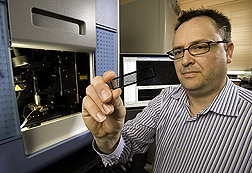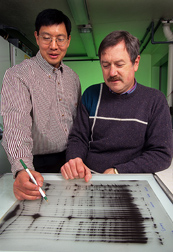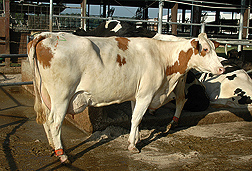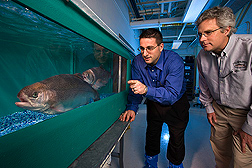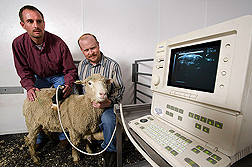Genomics, Phenomics Research Paves
the Way for Improved Animal Health and Productivity
|
|
The Agricultural Research Service’s genomics and phenomics research is laying the foundation for future livestock production improvements. Understanding how inherited characteristics relate to specific genomes will eventually allow researchers to develop tools that can be used to guide animal breeding, selection, and management decisions. Throughout the United States, ongoing ARS research projects are changing the way industry members breed, raise, and produce our nation’s most valuable agricultural animals.
Identifying DNA Markers and Traits
ARS scientists at Clay Center, Nebraska, and Miles City, Montana, joined an international consortium in sequencing the bovine genome in 2002. Today, ARS scientists throughout the country are using this information to improve beef cattle management and production.
Some ARS researchers are using genomic research to improve animal health. This is particularly useful in situations with infected but asymptomatic cattle, says Mohammad Koohmaraie, former director of the Roman L. Hruska U.S. Meat Animal Research Center (USMARC) at Clay Center. For example, cattle can carry diseases like bovine respiratory disease (BRD) without having symptoms. This complicates attempts to assess their genetic resistance. Having ways to identify asymptomatic cattle or those at higher risk of illness would allow scientists to more accurately gauge how genes affect resistance.
|
|
To improve their assessments, USMARC researchers led by geneticist Larry Kuehn are working with scientists at the ARS National Animal Disease Center in Ames, Iowa, to develop large collections of cattle phenotypes, or observable traits. These include traits such as general immune-system functionality, body temperature, respiratory rate, and feeding behavior. The phenotypes will be drawn from populations representing prominent breeds in the U.S. beef industry.
“By examining a larger group of traits, we can more accurately classify animals into categories according to their potential disease risk or resilience,” Koohmaraie says. This will enable researchers to identify traits that are most indicative of potential BRD risk and determine how those traits relate to genetic resistance to it.
One tool that could help scientists in this and other projects is the Illumina Bovine SNP50 BeadChip—a glass slide containing thousands of DNA markers called “single nucleotide polymorphisms,” or SNPs, which are used to find relationships between DNA markers and traits of economic importance.
The BeadChip has research applications for both beef and dairy cattle. Design was led by ARS researchers at Beltsville, Maryland, in collaboration with scientists at Clay Center, the University of Missouri, and the University of Alberta in Canada. The chip is being used at all those locations and many others—a total of at least 23 locations in 11 countries.
A single chip generates about 53,000 genotypes for each of 12 individual animals. DNA samples from the animals are applied to the BeadChip, chemically labeled, and scanned to produce genotypes. Statistical analyses of genotypes can identify relationships between DNA markers and economically relevant production traits.
“Genomic tools like the 50K SNP chip will provide the greatest opportunity to transfer our genomic discoveries in a usable form to the industry,” Koohmaraie says.
Beef Cattle: Fat and Feed Efficiency
One project using the BeadChip technology is a USMARC investigation into the influence of genetics on feed efficiency. Research leader Cal Ferrell, geneticist Mark Allan, and their colleagues are identifying phenotypes that relate to postweaning feed efficiency and lifetime productivity in beef cattle.
“One objective of the study is to determine the genetic variation in feed efficiency among individuals and breeds, using quantitative and genomic technologies,” Ferrell says. The researchers are also using the genotypes generated from the chip to find relationships between DNA markers and phenotypes that can be used to enhance genetic selection in beef cattle.
“These studies could lead to development of genomic tools that could enhance the accuracy of breeding and management decisions,” Allan says. “Genetic markers provide opportunities to improve selection for traits that are difficult to measure in an industry setting.”
ARS scientists are also using genomic research to improve beef cattle production at the Fort Keogh Livestock and Range Research Laboratory in Miles City, Montana. There, they have identified genetically significant areas called “quantitative trait loci” (QTLs) related to production traits such as beef quality and composition, feed efficiency, and reproductive success.
“Our work has led us to loci with significant effects on beef quality and composition, which have potential implications for human health,” says geneticist Mike MacNeil. MacNeil, geneticist Lee Alexander, and physiologist Tom Geary have collaborated with USMARC geneticist Warren Snelling to analyze whole-genome scans of 328 cattle bred by crossing Wagyu and Limousin parents. Wagyu is a Japanese breed with substantially more marbling than the more muscular French breed, Limousin.
In all, the team has identified seven QTLs related to tenderness, palatability, and fat composition. They found a region on chromosome 2 that influences the concentration of monounsaturated fat—believed to be healthier than saturated fat—in beef. With further research, in collaboration with USMARC chemist Tim Smith, they hope to develop genetic markers associated with the variation in this trait. That could ultimately lead to identification of the gene or genes responsible and allow for marker-assisted selection in other cattle breeds to alter the fatty acid content of the meat.
Cream of the Crop: Breeding Better Dairy Cattle
ARS scientists at Beltsville played a vital role in designing the BeadChip and are using it in genomics-based studies on dairy cattle. Beltsville geneticist Curt Van Tassell is leading development of a new genomic method to identify bulls that produce daughters with optimum milk production, calving ease, and other traits.
|
|
“Progeny testing,” the method now used to determine a bull’s genetic merit, is time-consuming and costly. At ARS’s Bovine Functional Genomics Research Unit, Van Tassell, with ARS geneticists Tad Sonstegard and George Wiggans, is working to whittle down the cost of progeny testing to about $500 a bull.
Their approach is called “genome-enhanced improvement.” It combines computer-aided statistical analysis with more than four decades’ worth of records on dairy performance and conformation to help locate desirable genes.
Collaborating with the Beltsville team are professors Jerry Taylor and Robert Schnabel with the University of Missouri-Columbia; and Illumina, the San Diego firm that manufactures the BeadChip.
The researchers plan to examine a total of 53,000 SNPs from 12,000 cows and bulls representing several commercial dairy breeds and an ARS research population at Beltsville. Then they’ll correlate SNP data to traits of interest, such as milk, fat, and protein production.
Eventually, information derived from the markers will help dairy producers streamline their identification and breeding efforts. And, Van Tassell says, cutting test costs while increasing the rate of genetic improvement in dairy cattle will help make the U.S. germplasm industry more competitive globally.
Healthy Chickens
Hans H. Cheng, a geneticist at the ARS Avian Disease and Oncology Laboratory in East Lansing, Michigan, worked with Michigan State University’s Jerry Dodgson, a microbiologist, to build the chicken genome map. Now, Cheng and his colleagues are using the map to identify resistance genes to Marek’s disease. These genes can be used to breed chickens with superior resistance. At the same time, the scientists have made molecular clones of the virus that causes the disease—a crucial first step to building more effective vaccines through biotechnology.
Since the initial sequencing of the chicken genome, many chicken gene sequences have been entered into the National Center for Biotechnology Information’s GenBank. This repository is one of the first places researchers look to see whether a gene sequence they are interested in has already been found and entered into the database.
Animal scientist Mark Richards, in the Animal Biosciences and Biotechnology Laboratory at Beltsville, is studying groups of genes involved in basic physiological functions, such as feed-intake regulation and nutrient use in poultry.
Of current interest is the gene that codes for the pancreatic hormone glucagon. Glucagon counterbalances insulin to regulate blood glucose levels in all vertebrates. It works to raise blood glucose that has been lowered by insufficient nutrition or stress.
The glucagon gene codes not only for glucagon, but also for other metabolic hormones, including the glucagon-like peptides 1 and 2 (GLP-1 and GLP-2). Each has unique physiological functions that are distinct from glucagon. Together, glucagon, GLP-1, and GLP-2 are contained in a precursor protein, called “proglucagon.”
“The glucagon gene is an interesting one to study because it functions differently in chickens than in other vertebrate species,” says Richards. For example, the glucagon gene is active in the pancreas of mammals, but in chickens, it’s expressed in high levels in the stomach too. Another difference is the number of precursor proteins produced by the glucagon gene. In chickens and mammals, the gene codes for a precursor protein that contains glucagon, GLP-1, and GLP-2. Richards’s team found that in chickens, it codes for an additional protein that contains just glucagon and GLP-1.
“The differences may be linked to the high levels of circulating glucose found in birds, which are more than twice the levels that are found in humans,” says Richards. “Such differences may help explain why chickens appear to be more resistant to insulin than mammals.”
ARS research is also shedding light on poultry pathogens, such as the parasite Eimeria. Eimeria causes coccidiosis, a disease that costs U.S. poultry producers more than $700 million annually. ARS immunologist Hyun Lillehoj is using genomics to decipher the molecular interactions between poultry and several strains of Eimeria that commonly infect poultry.
Working with her colleagues at the Animal Parasitic Diseases Laboratory in Beltsville, Lillehoj has identified key genes of poultry immune cells that respond to the presence of Eimeria. Some genes encode important cytokines and chemokines, molecules produced by white blood cells to kick-start the immune response after infection. These genes exhibit a heightened response the first time a bird is infected with Eimeria. But in later infections, these same genes have a much more modulated response. Sometimes their activity levels stay the same or even decrease below the levels observed in uninfected birds.
“Understanding how these different intestinal immune cells and molecular signals function in the face of Eimeria infection is a key step in developing new, effective vaccines,” Lillehoj says. “These findings will go a long way towards helping us find ways to control coccidiosis without using antibiotics.”
The Next Pig Thing
A farmer in Iowa wants to breed pigs that will produce lean, tender meat. An animal health inspector in North Carolina wants to identify the origin of a contagious virus that has spread throughout the state. A consumer advocacy group in California wants to verify the labeling accuracy of name-brand pork products available at local stores. Recent advances in swine genomic research mean that such goals are easier to achieve than ever before.
USMARC scientists are collaborating with an international coalition of researchers to sequence the swine genome. This has led to expansion of publicly available DNA-based tools, which are facilitating improved production efficiency and animal health.
The coalition—the Swine Genome Sequencing Consortium (SGSC)—includes ARS; the USDA Cooperative State Research, Education, and Extension Service; the University of Illinois; the Alliance for Animal Genomics; England’s Wellcome Trust Sanger Institute; Scotland’s Roslin Institute; the Korean Livestock Institute; the Beijing Genome Institute; Iowa State University; North Carolina State University; the National Park Board; North Carolina Pork Producers; France’s National Institute for Agricultural Research, and many other organizations. Since its inception in 2003, the SGSC has pieced together more than 267,000 segments across all pig chromosomes. This information can be viewed at http://pre.ensembl.org/Sus_scrofa/index.html.
“USMARC scientists have led the field in developing publicly available SNP markers,” says animal geneticist Gary Rohrer, who’s leading the ARS swine genome research efforts.
He and his colleagues at USMARC, the University of Illinois, Iowa State University, and the National Pork Board are developing a SNP chip similar to the one being developed for cattle. Though the swine genome hasn’t been completely sequenced, the researchers have developed markers that enable them to identify individuals, determine parentage, and predict offspring performance.
ARS researchers have made many contributions to the international scientific community’s understanding of livestock genomics. Their continuing input to this ever-expanding body of knowledge will have benefits for agriculture throughout the world.—By Laura McGinnis, Sharon Durham, Ann Perry, Jan Suszkiw, and Don Comis, Agricultural Research Service Information Staff.
This research is part of Food Animal Production (#101) and Animal Health (#103), two ARS national programs described on the World Wide Web at www.nps.ars.usda.gov.
To reach the scientists mentioned in this article, contact Laura McGinnis, USDA-ARS Information Staff, 5601 Sunnyside Ave., Beltsville, MD 20705-5129; phone (301) 504-1654, fax (301) 504-1486.
|
|
Cool Cows
ARS genomics research is also helping beef cattle beat the heat, thanks to researchers at the Subtropical Agricultural Research Station (STARS) in Brooksville, Florida. They have identified molecular markers tightly linked to the Slick gene, which codes for short, sleek hair that helps keep cattle cool in subtropical heat.
The discovery is very important to the beef cattle industry, since it should greatly facilitate the Slick gene’s introgression, or movement, into other economically important breeds, such as Holstein or Angus, to improve their heat tolerance. Many studies in Florida have shown slick-haired animals to have internal temperatures about 1˚F lower during summer than contemporaries with normal hair coats.
Mapping the gene’s locus is the first step towards identifying the mutation responsible for slick hair coat. STARS researchers have found a strong association between at least two closely positioned markers on chromosome 20 and the slick-haired phenotype. The markers were identified through DNA sequencing.
These results suggest a role for marker-assisted selection to identify homozygous Slick bulls—that is, sires with the same alleles—that will produce only slick-haired progeny. Some Senepol bulls were tested using these markers, and the results indicated excellent potential for identifying homozygous bulls. The same gene also appears to be responsible for the slick hair coat in Romosinuano cattle.—By Alfredo Flores, Agricultural Research Service Information Staff.
|
|
Fabulous, Fit Fish
ARS genomics research has been instrumental in identifying economically significant genes not only in livestock, but also in fish.
Scientists Caird Rexroad and Yniv Palti, at the National Center for Cool and Cold Water Aquaculture in Leetown, West Virginia, have developed tools for rainbow trout genome research. This includes construction of a genetic map that is being integrated with a physical map to facilitate alignment of the trout genome with the sequenced genomes of model organisms.
The scientists and their collaborators have developed functional genomic technologies to identify genes that affect disease resistance and stress tolerance. In addition, the entire genome of the bacterial pathogen Flavobacterium psychrophilum—which causes bacterial cold water disease—has been sequenced and annotated by molecular biologist Greg Wiens, microbiologist Tim Welch, and collaborators. This work should help identify virulence genes and vaccine targets. Bacterial cold water disease is a chronic and potentially fatal condition, especially in young fish.
How fish use nutrients is another important aspect of aquaculture genomics. For fish geneticist Ken Overturf and colleagues at Hagerman, Idaho, the ideal rainbow trout’s genetic makeup would allow it to thrive well on feeds that provide nutritious proteins and oils from plants instead of from fish. That would give growers of plant crops a new market and reduce aquaculture’s reliance on ocean-going fish for trout-feed ingredients. A study that involved testing about 1 million rainbow trout identified a genetic characteristic that distinguishes those that may grow well on plant-based feed.
ARS research has also promoted the use of genomics to identify fish breeds. At Stoneville, Mississippi, scientists in the Catfish Genetics Research Unit—led by research leader Kenneth Davis, molecular biologist Geoff Waldbieser, and geneticist Brian Bosworth—have developed a genotyping system to identify blue catfish, channel catfish, and their hybrids as early as 1 day after fertilization.
The Stoneville team has also developed genotyping systems to identify the parents of catfish spawn collected from communally stocked ponds, as well as individual catfish strains. Now the scientists are developing molecular methods to determine the sex genotype of hormonally feminized channel catfish. It’s a big step toward developing a YY strain that will sire only faster growing males.—By Sharon Durham, Marcia Wood, and Alfredo Flores, Agricultural Research Service Information Staff.
On the Lamb
Keeping America’s sheep healthy and productive while expanding the market for wool and lamb is the goal of researchers who seek to match the animals’ physical traits to the genes that underpin their expression.
ARS scientists are pursuing the research mainly at three ARS locations: the Animal Diseases Research Unit (ADRU) in Pullman, Washington; the U.S. Sheep Experiment Station in Dubois, Idaho; and the U.S. Meat Animal Research Center at Clay Center, Nebraska.
At Dubois, research leader Gregory Lewis and colleagues are investigating characteristics such as reproductive efficiency, mineral retention, and suitability for breeding. Geneticist Michelle Mousel has created a small repository, or bank, of frozen tissue specimens from the station’s onsite flock, which includes about 6,000 lambs, ewes, and rams. Additional specimens are taken to support the unit’s DNA analysis and genotyping efforts.
In one study, ADRU microbiologist Lynn Herrmann-Hoesing is using the tissue samples to study alleles (alternate gene copies) associated with an immune response in sheep to the ovine progressive pneumonia virus.
“This collaboration has been quite productive,” says Herrmann-Hoesing, who has developed a molecular quantitation test for the virus with ARS colleagues Stephen White and Donald Knowles. “Molecular quantitation tests could offer significant long-term economic advantages for the producer since they measure infectious-agent levels and relate to clinical disease,” she says.
Another health concern is scrapie, a degenerative neurological disease of sheep that costs the U.S. sheep industry $20 million in annual losses. At Clay Center, microbiologist Michael P. Heaton and colleagues have examined nucleotide variations in the prion gene that affect the protein believed to cause scrapie.
Using DNA analysis and genotyping procedures, they identified sheep with more than 21 possible combinations of prion gene alleles, or haplotypes. This, in turn, has given rise to faster, better, and cheaper methods of detecting scrapie susceptibility in sheep and may eventually eliminate their predisposition to the disease through selective breeding.
On the production front, researchers at Clay Center and Dubois are conducting parallel studies with Texel sheep on the so-called “myostatin mutation.” This genetic quirk has the potential, through conventional breeding, to increase the size of lamb chops without negatively affecting their tenderness.
“With genotyping, we can move that myostatin gene, over a period of time, into less heavily muscled breeds,” says Lewis. Eventually, he adds, “We may even be able to change the nutritional profile of those cuts.”—By Jan Suszkiw, Agricultural Research Service Information Staff.
"Genomics, Phenomics Research Paves the Way for Improved Animal Health and Productivity" was published in the August 2008 issue of Agricultural Research magazine.











